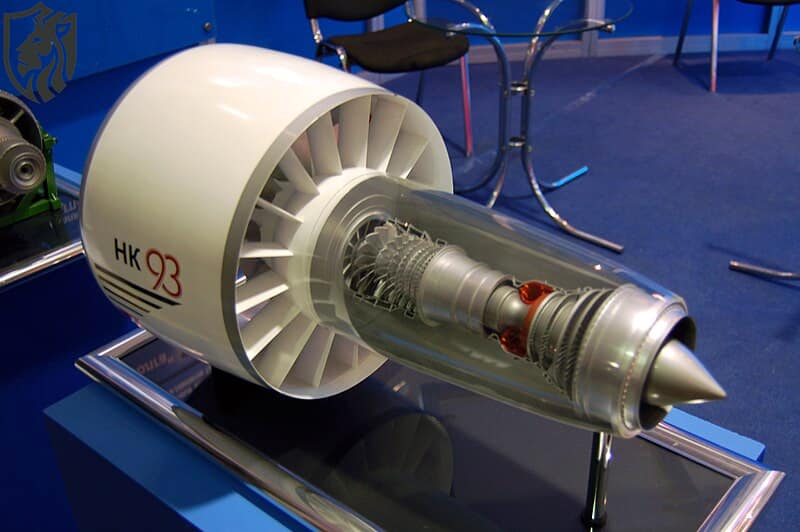
Kuznetsov NK-93
The USSR Kuznetsov NK-93 was a radical Soviet engineering marvel—a propfan engine that combined the speed of a jet with the fuel economy of a turboprop. Built in the 1980s, it delivered remarkable performance with a bypass ratio over 16:1, far beyond any commercial engine at the time.
Engineers believed it could cut fuel consumption by 30% compared to Western rivals. Despite successful tests on an Il-76 testbed and praise for its quiet operation and futuristic design, the NK-93 never entered production. Funding cuts, geopolitical shifts, and the fall of the USSR buried the project. Today, it remains one of the greatest “what ifs” in aviation history—an ultra-efficient engine that arrived decades too soon.
Why the Kuznetsov NK-93 Propfan Still Matters
Propulsion efficiency is crucial to the success of defence logistics. The Kuznetsov NK-93 propfan pursued jet-like cruise with turboprop thrift, promising a step-change for airlift and ISR fleets.
With a reported bypass ratio above 16:1 and projected fuel savings near 30%, it targeted lower specific fuel consumption, longer legs, and fewer tanker touches. For expeditionary forces, that means fewer refuelling events, reduced basing dependence, and more payload margin.
Propfan Basics—and the NK-93’s Twist
Propfans accelerate a large mass of air more gently than conventional turbofans. Consequently, they recover propulsive efficiency by lowering exhaust velocity. The Kuznetsov NK-93 propfan added a short shroud, contra-rotating variable-pitch stages, and a reduction gearbox to balance acoustic limits with high subsonic performance. This hybrid approach preserved nacelle integration advantages while keeping disc loading and tip speeds under control.

Military Payoffs: Range, Endurance, and Payload
In theatre lift operations, every percentage of fuel saved accumulates across multiple sorties. Therefore, the Kuznetsov NK-93 propfan would have extended unrefuelled reach or unlocked extra cargo on routes constrained by tanker capacity.
Maritime patrol and ISR platforms also benefit: higher subsonic efficiency enables wider sweeps without cutting on-station time. Tankers and special-mission aircraft would gain longer orbits at similar speeds, easing demand on finite refuelling assets.
Acoustics, Signatures, and Basing Flexibility
Propfans once carried a noise stigma; however, flight test notes on the Il-76 testbed highlighted comparatively quiet operation for the class. The Kuznetsov NK-93 propfan used a blade sweep, variable pitch, and partial shrouding to dampen tonal peaks.
Quieter operations broaden basing options at civilian fields, which improves dispersal and resilience. Infrared signature may also fall with better thermodynamic efficiency, although radar aspects of the large rotating disc demand careful airframe shielding.
Integration Realities: Airframes and Maintenance
Large-diameter, contra-rotating fans introduce gearbox loads, torsion, and unique vibratory modes. Even so, variable pitch delivers precise thrust control, short-field reverse, and efficient part-power loiter.
Integrating the Kuznetsov NK-93 propfan on platforms akin to the Il-76 family would require reinforced pylons, tuned mounts, and digital engine control laws that manage transients, gearbox temperatures, and blade-angle schedules.
Contested Logistics: Fuel Savings as Combat Power
In contested logistics, fuel is a vulnerability. Because the Kuznetsov NK-93 propfan promised double-digit burn reductions, it would have trimmed fuel convoys, depot storage, and aerial refuelling demand.
Moreover, those savings turn into extra days of ISR coverage or additional resupply cycles. Over a campaign, they also reduce cost per flying hour, freeing budget for sensors, EW kits, and survivability upgrades.

Why It Didn’t Field—and What We Learned
The physics worked; the politics did not. The programme survived bench runs and test flights, but post-Soviet funding gaps and a lack of a dedicated launch airframe stalled certification and production.
However, the Kuznetsov NK-93 propfan teaches us important lessons: connect an engine to a main aircraft early, keep funding during the certification process, and make sure improvements in engine technology match mission goals that can quickly make
The 2030s Open-Fan Revival
Today’s open-fan research—leveraging advanced composites, 3D aerodynamics, and digital controls—attacks 1980s pain points. Therefore, airframers can revisit NK-93-class efficiency with lower cabin noise and certification-ready behaviour.
Defence users should shape requirements now: cruise Mach, acoustic caps, runway performance, and nacelle survivability. If fielded, a modern Kuznetsov NK-93 propfan analogue could rewire airlift, ISR, and tanker economics.
Procurement Considerations for Defence Planners
Program success hinges on a few difficult choices. First, pair the engine with a medium airlifter or maritime patrol platform from the outset. Second, codify dispersed-basing needs into acoustic and FOD tolerance requirements. Third, budget for gearbox and blade-actuation maintenance while banking on lower fuel bills. Finally, incentivise export-friendly certifications to unlock coalitional commonality.
The Enduring “What If”
The Kuznetsov NK-93 propfan arrived early, yet its core logic has only grown stronger. As forces seek reach without a heavier logistics tail, ultra-high-bypass propfans remain one of the most credible routes to strategic efficiency—jet speed with turboprop thrift and options that multiply as fuel burn falls.









